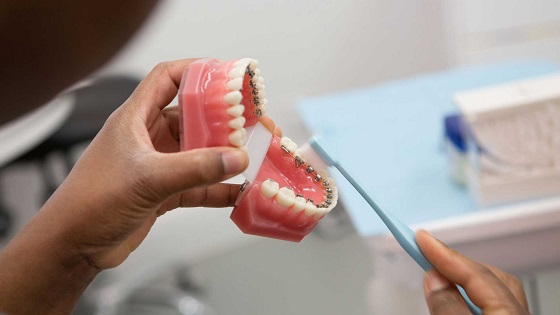While lingual supports are the same old thing in the realm of tooth-adjusting orthodontic strategies, there are still a ton of inquiries individuals have about this procedure. Like all different systems used to accomplish straight teeth, lingual supports have various favorable circumstances and weaknesses.
On the off chance that you need to become familiar with lingual supports and how they work, keep pursuing underneath.
What Are Lingual Braces?
Lingual braces are a kind of braces that are put behind the teeth, confronting the tongue and sense of taste, rather than before the teeth like customary supports. This is an extraordinary restorative option for the individuals who need to fix their teeth without the noticeable metal sections.
There are various advantages of lingual braces. The way that they are undetectable, generally, makes them very famous among grown-ups, particularly models, entertainers, and individuals who are continually in the open eye.
Another preferred position is for individuals who play wind instruments, as they can have less issues due to the particular arrangement of lingual braces.
Lingual braces can likewise address troublesome dental issues, for example, holes, revolutions, and can change the status of teeth. One other advantage is being excused from helpless dental cleanliness. Patients wearing supports are needed to keep up legitimate cleanliness and brush their teeth at any rate once every day.
For patients who disregard cleanliness, a specific discolouration on teeth can happen subsequent to eliminating the supports. Since lingual supports are put behind the teeth, this discolouration won’t be obvious.
How Do Lingual Braces Work?

Lingual braces work unequivocally equivalent to customary braces. They are composed of a similar material and in this manner, fix similar dental issues. Each six to about two months, your orthodontist will plan an arrangement and modify the supports to enable your teeth to move into their appropriate positions.
In the event that you choose to get lingual braces, your orthodontist may take a dental impression or output your teeth. The sections are specially designed for every patient’s teeth, and you should wear them between 18 to two years, contingent upon the seriousness of your dental issues.
7 Things You Should Know About Lingual Braces
1. Braces Placement

While the material and methodology are equivalent to conventional supports, this sort of braces is set behind the teeth, offering practically full imperceptibility. It is ideal for individuals who would prefer not to show that they are fixing their teeth or individuals whose activity keeps them from having customary braces.
2. Correlation with Other Methods
Lingual braces are by all account not the only imperceptible choice accessible. There are different supports, for example, Invisible Braces, which offer a comparative sort of treatment. Be that as it may, with regards to lingual braces versus Invisible Braces, you should realize that Invisible Braces offers a plate style fixing technique.
That implies the braces are not lasting, are removable, and you need to wear it for a specific timeframe with the goal for it to be viable. Lingual braces are for all time set on your teeth, so you don’t need to make sure to wear them. Invisible Braces is made of plastic and now and again can’t fix serious dental issues.
Additionally, you may need to visit your orthodontist all the more often for check ups, while lingual braces require modification and fixing each six to about two months.
3. Cost
With regards to the advantages and disadvantages of lingual braces, the cost will in general move to the cons section. While they are like conventional braces, they now and then require singular customization to fit every tooth consummately, which can build their expense.
4. Food Restrictions
The vast majority wonder what not to eat with lingual braces. Like conventional braces, you should dodge hard food, for example, old fashioned corn or apple, as it could break the braces. Keeping away from clingy nourishments, for example, caramel or specific kinds of treats is prudent as it will stick behind the braces and will be difficult to dismiss.
5. Cleanliness Requirements

Since lingual braces are undetectable, it might be more enthusiastic to brush your teeth and clean all the sections. Thus, purchasing a dental specialist’s mirror can be a commendable speculation, as it will permit you a superior perspective on what should be cleaned.
6. Different Difficulties
Lingual braces may cause a few troubles with discourse until you become accustomed to them. This normally endures half a month. It can cause tongue bothering, as it is uncommon to have sections put in behind teeth and you will surge your tongue to review it.
Other mouth distresses might be available, however these impacts will disappear rapidly. The preferred position is that solitary your tongue will be in contact with the supports, so aggravation of gums and cheeks is non-existent.
7. Greater Flexibility
Lingual braces are more adaptable, which means they don’t need to be set on all teeth. The treatment plan relies upon the dental issues you are confronting.
In the event that you don’t have any hidden ailments, for example, a sporadic nibble, at that point an orthodontist can put the supports just on the teeth which need fixing. An absolutely corrective treatment costs less as the supports will be introduced just where required.
Conclusion
Lingual braces are an ideal apparatus for fixing teeth and managing more extreme dental issues, while offering circumspection simultaneously. They are totally undetectable and an astounding decision for individuals whose social or expert circumstance doesn’t take into account conventional supports.
On the off chance that 7 Thing You Should Know About Lingual Braces are the correct decision for you, contact you Orthodontics and start your excursion to an ideal grin.
Expert opinion
- Dr. Ankita Gada lingual braces gives you an advantage to go modern and change the step from traditional to modern.”





